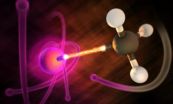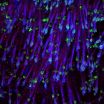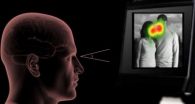(Press-News.org) MANHATTAN, Kansas — Ultrafast X-ray laser research led by Kansas State University has provided scientists with a snapshot of a fundamental molecular phenomenon. The finding sheds new light on microscopic electron motion in molecules.
Artem Rudenko, assistant professor of physics and a member of the university's James R. Macdonald Laboratory; Daniel Rolles, currently a junior research group leader at Deutsches Elektronen-Synchrotron in Hamburg, Germany, who will be joining the university's physics department in January 2015; and an international group of collaborators studied how an electron moves between different atoms in an exploding molecule.
Researchers measured at which distances between the two atoms the electron transfer can occur. Charge transfer processes — particularly electron transfer — are important for photosynthesis in solar cells, and drive many other important reactions in physics, chemistry and biology.
Their observation, "Imaging charge transfer in iodomethane upon x-ray photoabsorption," appears in the journal Science.
"There is a very fundamental question about how far an electron can go to reach the nearby atom in a molecule, and how probable that transition is," Rudenko said. "It has been difficult to capture images of this motion because of the very short times and very small distances that need to be measured."
To find the answer, scientists shot an ultrafast optical laser at iodomethane molecules — molecules made of an iodine atom and a methyl group — to break the bond of these two partners.
The molecules were hit with an intense, ultrashort X-ray pulse to strip the electrons from the inner shells of the iodine atom as well as to study the charge transfer between the fragments. The experiment was performed using the Linac Coherent Light Source, the world's most powerful X-ray laser. The laser is at the SLAC National Accelerator Laboratory in California and delivers femtosecond X-ray pulses. One femtosecond is one-millionth of a billionth of a second.
Researchers were able to see electrons jumping over surprisingly long distances — up to 10 times the length of the original, intact molecule.
"Conceptually the study was pretty simple," Rudenko said. "We break up the molecule with the optical laser, use the X-rays to knock a few electrons from the iodine atom, and control the distance to the neighboring methyl group by tuning the timing between the laser and the X-rays. Then we watch how many electrons move from the methyl side to the iodine side to fill the created holes."
The study recently became possible because of the unique combination of ultrafast optical and X-ray pulses, and researchers' expertise in particle detection.
"In the near future we will be able to perform similar experiments with improved time resolution using ultrafast lasers and tabletop soft X-ray sources at the J.R. Macdonald Lab at Kansas State University," Rudenko said.
INFORMATION:
Rudenko and Rolles, who served as the study's principal investigators, conducted the research together with colleagues from the former Max Planck Advanced Study Group, Center for Free-Electron Laser Science and the Deutsches Elektronen-Synchrotron in Hamburg; Max Planck Institutes for Nuclear Physics and Medical Research in Heidelberg, Germany; the Physikalisch-Technische Bundesanstalt in Braunschweig, Germany; the SLAC National Accelerator Laboratory; and Sorbonne University and the National Center for Scientific Research in Paris, France.
Ultrafast X-ray laser sheds new light on fundamental ultrafast dynamics
2014-07-17
ELSE PRESS RELEASES FROM THIS DATE:
No evidence that California cellphone ban decreased accidents, says Colarado University Boulder researcher
2014-07-17
In a recent study, a researcher at the University of Colorado Boulder found no evidence that a California ban on using hand-held cellphones while driving decreased the number of traffic accidents in the state in the first six months following the ban.
The findings, published in the journal Transportation Research Part A: Policy and Practice, are surprising given prior research that suggests driving while using a cellphone is risky. For example, past laboratory studies have shown that people who talk on a cellphone while using driving simulators are as impaired as people ...
Peering into giant planets from in and out of this world
2014-07-17
Lawrence Livermore scientists for the first time have experimentally re-created the conditions that exist deep inside giant planets, such as Jupiter, Uranus and many of the planets recently discovered outside our solar system.
Researchers can now re-create and accurately measure material properties that control how these planets evolve over time, information essential for understanding how these massive objects form. This study focused on carbon, the fourth most abundant element in the cosmos (after hydrogen, helium and oxygen), which has an important role in many types ...
Help wanted: Principals who love change
2014-07-17
DALLAS (SMU) – Training principals for new roles is key to U.S. Department of Education school reforms, according to a new report by SMU researchers. But insufficient training and support for principals to meet the new expectations is leading to a leadership crisis. Twenty percent of newly minted principals leave the profession after two years and seasoned professionals are opting for early retirement.
Education researchers Lee Alvoid and Watt Lesley Black Jr. examine school districts at the forefront of supporting and training effective principals in their report "The ...
CNIO researchers discover a gene that links stem cells, aging and cancer
2014-07-17
An organism is healthy thanks to a good maintenance system: the normal functioning of organs and environmental exposure cause damage to tissues, which need to be continuously repaired. This process is not yet well understood, but it is known that stem cells in the organs play a key role, and that when repair fails, the organism ages more quickly. Researchers from the Spanish National Cancer Research Centre (CNIO) have "discovered one of the key genes that make up the maintenance mechanism for tissues" says Miguel Foronda, the first author of the manuscript.
The study ...
First ab initio method for characterizing hot carriers
2014-07-17
One of the major road blocks to the design and development of new, more efficient solar cells may have been cleared. Researchers with the Lawrence Berkeley National Laboratory (Berkeley Lab) have developed the first ab initio method – meaning a theoretical model free of adjustable or empirical parameters – for characterizing the properties of "hot carriers" in semiconductors. Hot carriers are electrical charge carriers - electrons and holes – with significantly higher energy than charge carriers at thermal equilibrium.
"Hot carrier thermalization is a major source of ...
Untangling spider's webs
2014-07-17
For decades, the story of spider evolution went like this: As insects became more and more diverse, with some species taking to the skies, spiders evolved new hunting strategies, including the ability to weave orb-shaped webs to trap their prey.
From that single origin, the story goes, orb-weaver spiders diverged along different evolutionary paths, leading to today, where several species weave similar – though not identical – webs.
It's a good story, but there's just one problem – Harvard scientists now know it's not true.
The largest-ever phylogenetic study of ...
Eye movements reveal difference between love and lust
2014-07-17
Soul singer Betty Everett once proclaimed, "If you want to know if he loves you so, it's in his kiss." But a new study by University of Chicago researchers suggests the difference between love and lust might be in the eyes after all.
Specifically, where your date looks at you could indicate whether love or lust is in the cards. The new study found that eye patterns concentrate on a stranger's face if the viewer sees that person as a potential partner in romantic love, but the viewer gazes more at the other person's body if he or she is feeling sexual desire. That automatic ...
Atlantic salmon also show capacity to adapt to warmer waters
2014-07-17
Populations of Atlantic salmon have a surprisingly good capacity to adjust to warmer temperatures that are being seen with climate change, a group of scientists at the University of Oslo and University of British Columbia have discovered. The finding about Atlantic species adds to recent UBC-supported research on heat tolerance of Pacific salmon.
The new study, a collaboration between Norwegian and Canadian researchers, was recently published in Nature Communications. Funded by the Norwegian Research Council, it addressed questions around how climate change might affect ...
Eating lean beef daily can help lower blood pressure
2014-07-17
Contrary to conventional wisdom, a growing body of evidence shows that eating lean beef can reduce risk factors for heart disease, according to recent research by nutritional scientists.
"This research adds to the significant evidence, including work previously done in our lab, that supports lean beef's role in a heart-healthy diet," said Penny M. Kris-Etherton, Distinguished Professor of Nutrition, Penn State. "This study shows that nutrient-rich lean beef can be included as part of a heart-healthy diet that reduces blood pressure, which can help lower the risk for cardiovascular ...
Gut microbes turn carbs into colorectal cancer
2014-07-17
Colorectal cancer has been linked to carbohydrate-rich western diets, but the underlying mechanisms have been unclear. A study published by Cell Press July 17th in the journal Cell shows that gut microbes metabolize carbohydrates in the diet, causing intestinal cells to proliferate and form tumors in mice that are genetically predisposed to colorectal cancer. Treatment with antibiotics or a low-carbohydrate diet significantly reduced tumors in these mice, suggesting that these easy interventions could prevent a common type of colorectal cancer in humans.
"Because hereditary ...



